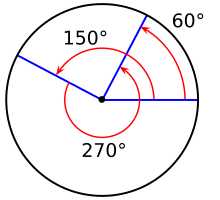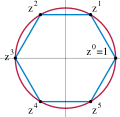Circle group

| Algebraic structure → Group theory Group theory |
|---|
 |
| Lie groups and Lie algebras |
|---|
 |
In mathematics, the circle group, denoted by or , is the multiplicative group of all complex numbers with absolute value 1, that is, the unit circle in the complex plane or simply the unit complex numbers[1]
The circle group forms a subgroup of , the multiplicative group of all nonzero complex numbers. Since is abelian, it follows that is as well.
A unit complex number in the circle group represents a rotation of the complex plane about the origin and can be parametrized by the angle measure :
This is the exponential map for the circle group.
The circle group plays a central role in Pontryagin duality and in the theory of Lie groups.
The notation for the circle group stems from the fact that, with the standard topology (see below), the circle group is a 1-torus. More generally, (the direct product of with itself times) is geometrically an -torus.
The circle group is isomorphic to the special orthogonal group .
Elementary introduction
[edit]One way to think about the circle group is that it describes how to add angles, where only angles between 0° and 360° or or are permitted. For example, the diagram illustrates how to add 150° to 270°. The answer is 150° + 270° = 420°, but when thinking in terms of the circle group, we may "forget" the fact that we have wrapped once around the circle. Therefore, we adjust our answer by 360°, which gives 420° ≡ 60° (mod 360°).
Another description is in terms of ordinary (real) addition, where only numbers between 0 and 1 are allowed (with 1 corresponding to a full rotation: 360° or ), i.e. the real numbers modulo the integers: . This can be achieved by throwing away the digits occurring before the decimal point. For example, when we work out 0.4166... + 0.75, the answer is 1.1666..., but we may throw away the leading 1, so the answer (in the circle group) is just , with some preference to 0.166..., because .
Topological and analytic structure
[edit]The circle group is more than just an abstract algebraic object. It has a natural topology when regarded as a subspace of the complex plane. Since multiplication and inversion are continuous functions on , the circle group has the structure of a topological group. Moreover, since the unit circle is a closed subset of the complex plane, the circle group is a closed subgroup of (itself regarded as a topological group).
One can say even more. The circle is a 1-dimensional real manifold, and multiplication and inversion are real-analytic maps on the circle. This gives the circle group the structure of a one-parameter group, an instance of a Lie group. In fact, up to isomorphism, it is the unique 1-dimensional compact, connected Lie group. Moreover, every -dimensional compact, connected, abelian Lie group is isomorphic to .
Isomorphisms
[edit]The circle group shows up in a variety of forms in mathematics. We list some of the more common forms here. Specifically, we show that where the slash () denotes group quotient and the existence of an isomorphism between the groups.
The set of all unitary matrices coincides with the circle group; the unitary condition is equivalent to the condition that its element have absolute value 1. Therefore, the circle group is canonically isomorphic to the first unitary group , i.e., The exponential function gives rise to a map from the additive real numbers to the circle group known as Euler's formula where corresponds to the angle (in radians) on the unit circle as measured counterclockwise from the positive x-axis. The property makes a group homomorphism. While the map is surjective, it is not injective and therefore not an isomorphism. The kernel of this map is the set of all integer multiples of . By the first isomorphism theorem we then have that After rescaling we can also say that is isomorphic to .
The unit complex numbers can be realized as 2×2 real orthogonal matrices, i.e., associating the squared modulus and complex conjugate with the determinant and transpose, respectively, of the corresponding matrix. As the angle sum trigonometric identities imply that where is matrix multiplication, the circle group is isomorphic to the special orthogonal group , i.e., This isomorphism has the geometric interpretation that multiplication by a unit complex number is a proper rotation in the complex (and real) plane, and every such rotation is of this form.
Properties
[edit]Every compact Lie group of dimension > 0 has a subgroup isomorphic to the circle group. This means that, thinking in terms of symmetry, a compact symmetry group acting continuously can be expected to have one-parameter circle subgroups acting; the consequences in physical systems are seen, for example, at rotational invariance and spontaneous symmetry breaking.
The circle group has many subgroups, but its only proper closed subgroups consist of roots of unity: For each integer , the th roots of unity form a cyclic group of order , which is unique up to isomorphism.
In the same way that the real numbers are a completion of the b-adic rationals for every natural number , the circle group is the completion of the Prüfer group for , given by the direct limit .
Representations
[edit]The representations of the circle group are easy to describe. It follows from Schur's lemma that the irreducible complex representations of an abelian group are all 1-dimensional. Since the circle group is compact, any representation must take values in . Therefore, the irreducible representations of the circle group are just the homomorphisms from the circle group to itself.
For each integer we can define a representation of the circle group by . These representations are all inequivalent. The representation is conjugate to :
These representations are just the characters of the circle group. The character group of is clearly an infinite cyclic group generated by :
The irreducible real representations of the circle group are the trivial representation (which is 1-dimensional) and the representations taking values in . Here we only have positive integers , since the representation is equivalent to .
Group structure
[edit]The circle group is a divisible group. Its torsion subgroup is given by the set of all -th roots of unity for all and is isomorphic to . The structure theorem for divisible groups and the axiom of choice together tell us that is isomorphic to the direct sum of with a number of copies of .[2]
The number of copies of must be (the cardinality of the continuum) in order for the cardinality of the direct sum to be correct. But the direct sum of copies of is isomorphic to , as is a vector space of dimension over . Thus,
The isomorphism can be proved in the same way, since is also a divisible abelian group whose torsion subgroup is the same as the torsion subgroup of .
See also
[edit]- Group of rational points on the unit circle
- One-parameter subgroup
- n-sphere
- Orthogonal group
- Phase factor (application in quantum-mechanics)
- Rotation number
- Solenoid
Notes
[edit]- ^ James, Robert C.; James, Glenn (1992). Mathematics Dictionary (Fifth ed.). Chapman & Hall. p. 436. ISBN 9780412990410.
a unit complex number is a complex number of unit absolute value
. - ^ Fuchs, László (2015). "Example 3.5". Abelian groups. Springer Monographs in Mathematics. Springer, Cham. p. 141. doi:10.1007/978-3-319-19422-6. ISBN 978-3-319-19421-9. MR 3467030.
References
[edit]- James, Robert C.; James, Glenn (1992). Mathematics Dictionary (Fifth ed.). Chapman & Hall. ISBN 9780412990410.
Further reading
[edit]- Hua Luogeng (1981) Starting with the unit circle, Springer Verlag, ISBN 0-387-90589-8.












![{\displaystyle \in (-\pi ,+\pi ]}](https://wikimedia.org/api/rest_v1/media/math/render/svg/d7294980dc982a7776d3a97efbe46cad85313d54)























![{\displaystyle \mathbb {Z} {\bigl [}{\tfrac {1}{b}}{\bigr ]}}](https://wikimedia.org/api/rest_v1/media/math/render/svg/7631ba07ed8232855fea30ed0c6b69747b4f2d94)

![{\displaystyle \mathbb {Z} {\bigl [}{\tfrac {1}{b}}{\bigr ]}~\!/~\!\mathbb {Z} }](https://wikimedia.org/api/rest_v1/media/math/render/svg/2fe2fbd1930fe4ccc4ea2b1108e89c91b5e9101b)

















